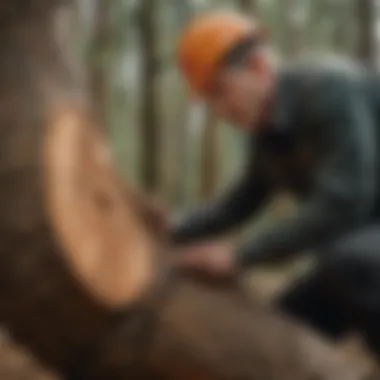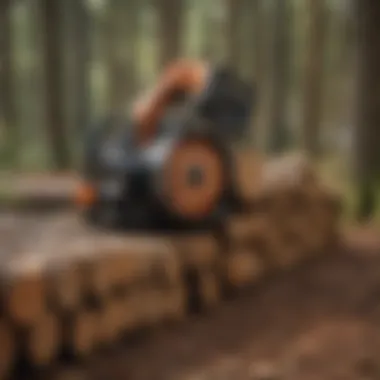Mastering the Craft of Tree Felling Wedges: A Detailed Guide


Evergreen Trees Species
When delving into the realm of evergreen trees, it's essential to understand the diverse array of species that populate American forests. From the towering pines to the majestic spruces, each species brings its unique characteristics and ecological significance to the forest ecosystem. Arborists and forestry professionals meticulously study these trees to enhance their understanding of how to best manage and preserve these valuable resources.
Types of Evergreen Trees
Exploring the various types of evergreen trees found in American forests reveals a tapestry of biodiversity. While the Douglas fir stands tall with its iconic cones, the Eastern white pine exudes elegance with its soft needles. Understanding the distinguishing features of each tree species aids forestry professionals in identifying, nurturing, and protecting these vital components of the forest landscape.
Ecological Significance
Evergreen trees play a pivotal role in maintaining ecological balance within forested areas. Their year-round greenery provides shelter and food for wildlife, contributing to the overall biodiversity of the ecosystem. Additionally, the roots of evergreen trees help prevent soil erosion, ensuring the stability of the forest floor and surrounding landscape. Recognizing the ecological significance of these trees underscores the importance of implementing conservation practices to safeguard their future.
Conservation Practices
Preservation efforts focused on evergreen tree species involve a multifaceted approach. Conservation practices encompass not only protecting existing trees but also planting new saplings to ensure the continuity of these species. Sustainable forestry practices, such as selective logging and reforestation initiatives, play a vital role in maintaining the health and longevity of evergreen forests. By highlighting the importance of conservation methods, forestry professionals aim to instill a sense of responsibility towards preserving these invaluable natural habitats.
Introduction
Tree felling is a critical aspect of arboriculture and forestry practices, requiring precision and expertise. In this comprehensive guide, we delve into the intricate techniques and tools involved in tree felling, with a particular focus on the vital role of wedges. Understanding the science behind tree felling and mastering the art of wedge placement is essential for arborists, forestry professionals, and nature enthusiasts seeking to effectively manage tree removal processes.
Understanding Tree Felling
In the realm of tree felling, the science behind the process holds significant importance. The precise application of scientific principles determines the safe and efficient felling of trees. Factors affecting tree felling, such as tree species, size, and environmental conditions, play a crucial role in planning felling operations. Employing proper techniques is paramount to ensure the safety of personnel and property during tree felling endeavors.
The Science of Tree Felling
The science of tree felling encompasses a spectrum of technical considerations, including tree physics, mechanical forces, and structural integrity. By comprehending the fundamental principles governing tree felling, arborists can strategically plan and execute tree removal operations with precision. Understanding the science behind tree felling facilitates the implementation of safe practices to mitigate potential risks and enhance operational efficiency.
Factors Affecting Tree Felling
Various factors influence the process of tree felling, such as tree morphology, environmental factors, and desired felling direction. By analyzing these variables, arborists can adapt their felling techniques to the specific characteristics of each tree, ensuring optimal outcomes and minimizing hazards. Moreover, considering the factors that affect tree felling allows for informed decision-making, leading to successful and safe tree removal.
Importance of Proper Techniques


Adhering to proper tree felling techniques is paramount for a successful operation. Implementing industry-approved practices minimizes risks associated with tree felling, promoting a safe working environment and efficient project completion. By prioritizing the importance of proper techniques, arborists can enhance their skill set, elevate safety standards, and achieve superior results in tree removal endeavors.
Role of Wedges in Tree Felling
Wedges play a crucial role in tree felling operations, serving as essential tools for controlling the direction of tree fall and preventing accidents. Understanding the overview of tree felling wedges, the different types available, and the inherent benefits of using wedges is instrumental for arborists seeking to streamline their felling processes.
Overview of Tree Felling Wedges
Tree felling wedges are specialized tools designed to assist in directional tree felling by creating leverage and controlling the tree's descent. These wedges come in various shapes and sizes, catering to different tree felling requirements and scenarios. The unique design of tree felling wedges enables arborists to optimize their felling techniques, ensuring precise and safe tree removal operations.
Types of Tree Felling Wedges
There are several types of tree felling wedges available, including wooden, plastic, and metal options. Each type offers distinct advantages depending on the specific felling conditions and tree characteristics. By familiarizing themselves with the different types of wedges, arborists can select the most suitable option for each felling project, maximizing efficiency and safety.
Benefits of Using Wedges
Utilizing wedges in tree felling offers numerous benefits, such as enhanced control over the tree's fall direction, increased safety during felling operations, and improved efficiency in tree removal. By incorporating wedges into their felling arsenal, arborists can effectively manage tree felling processes, mitigate risks, and achieve optimal results with precision and expertise.
Choosing the Right Wedge
In this next section of the comprehensive guide on the art of tree felling wedges, we delve into the crucial aspect of selecting the appropriate wedge for the task at hand. The choice of wedge plays a pivotal role in ensuring the success and safety of the felling process. This segment focuses on the various elements, benefits, and considerations associated with selecting the right wedge.
Material Composition
Wooden Wedges
The wooden wedge stands out for its traditional yet effective design, offering stability and durability during tree felling operations. Its key characteristic lies in its natural material composition, which provides a reliable and sturdy wedge for professionals in the forestry industry. Wooden wedges are favored for their ability to absorb impact and prevent slipping, making them a popular choice for ensuring precise and controlled tree felling. While wooden wedges may be heavier compared to other materials, their resilience and grip make them a preferred option in this article.
Plastic Wedges
Plastic wedges offer a modern twist to traditional tree felling tools, incorporating lightweight and durable properties for enhanced maneuverability. Their key characteristic includes flexibility, allowing them to adapt to various tree sizes and conditions. Plastic wedges are a beneficial choice for their ease of handling and transport, making them popular among arborists and forestry professionals seeking convenience during operations. Despite their advantages, plastic wedges may be prone to breakage under extreme pressure, a factor to consider when using them in tree felling scenarios.
Metal Wedges


Metal wedges introduce a sturdy and robust option for tree felling activities, known for their strength and precision in wedge placement. The key characteristic of metal wedges lies in their durability and sharpness, enabling them to penetrate tough wood with efficiency. Metal wedges are a popular choice for their long-lasting nature and ability to withstand heavy impact without deformity. However, their weight and potential to cause damage to chainsaws or other tools should be considered when opting for metal wedges in this article.
Size and Shape Considerations
Length and Width
Exploring the dimensions of wedges, the length and width play a crucial role in determining the effectiveness of wedge placement. The key characteristic of length and width in wedges lies in their influence on the angle of felling and the control exerted over the direction of the tree's fall. Optimal length and width ensure stability and precision during felling operations, making them a beneficial choice for achieving desired outcomes. While longer and wider wedges offer enhanced control, they may be challenging to maneuver in tighter spaces, a factor to consider based on the felling environment.
Tapered vs. Straight Wedges
Comparing tapered and straight wedges, the choice depends on the specific requirements of the tree felling task. Tapered wedges feature a gradual incline, allowing for efficient penetration and adjustment during extraction. The key characteristic of tapered wedges lies in their ability to widen fissures and create controlled splitting, offering precise control over the tree's descent. In contrast, straight wedges provide uniform force distribution for straightforward felling but may lack the versatility of tapered wedges in adjusting the tree's direction. Understanding the unique features of both types enables professionals to select the most suitable wedge for the intended felling goals in this article.
Effective Wedge Placement
Effective wedge placement is a crucial aspect of tree felling that demands meticulous consideration. In this comprehensive guide, we delve into the specific elements, benefits, and considerations surrounding effective wedge placement. Understanding how to strategically position wedges for optimal tree felling outcomes is essential for arborists, forestry professionals, and nature enthusiasts alike. By focusing on the precise placement of wedges, individuals can significantly enhance safety levels and increase efficiency throughout the tree felling process.
Strategic Placement Techniques
Undercutting Strategy
The undercutting strategy is a fundamental component of effective wedge placement during tree felling. This technique involves creating a precise cut underneath the tree, strategically positioning the wedge to control the direction of the tree's fall. The key characteristic of the undercutting strategy lies in its ability to guide the tree's descent with accuracy, minimizing the risk of unpredictable falls. Arborists and forestry experts favor this method due to its reliability and ability to safeguard against potential hazards. One unique feature of the undercutting strategy is its capacity to mitigate tree felling risks by providing a controlled path for the tree's collapse.
Backcutting Method
The backcutting method serves as another vital technique in the realm of effective wedge placement. By making a cut at the back of the tree opposite the undercut, individuals can influence the direction of the tree's fall with precision. The primary characteristic of the backcutting method is its role in complementing the undercutting strategy, ensuring a controlled and safe tree felling process. This method is widely recognized for its effectiveness in guiding trees towards the desired landing spot, making it a popular choice among forestry professionals seeking precise outcomes. A key unique feature of the backcutting method is its ability to facilitate a smoother tree fall by strategically managing the tree's balance points.
Avoiding Binding Situations
Successfully avoiding binding situations is imperative for ensuring safe and efficient wedge placement during tree felling. A binding situation occurs when the tree becomes trapped during the falling process, posing a significant risk to those involved. By carefully assessing the tree's condition and surroundings, individuals can proactively prevent binding scenarios by adjusting wedge placement and cutting techniques. The key characteristic of avoiding binding situations is the proactive approach it entails, safeguarding against potential accidents and property damage. One unique feature of this technique is its emphasis on preemptive measures to maintain control over the tree felling process, reducing the likelihood of unforeseen complications.
Safety Measures
Protective Gear


Prioritizing the use of proper protective gear is paramount when engaging in tree felling activities. Protective gear, including helmets, goggles, gloves, and boots, plays a fundamental role in safeguarding individuals from potential hazards during the tree felling process. The key characteristic of protective gear is its ability to minimize the risk of injuries and ensure the safety of arborists and forestry professionals throughout their work. This equipment is a popular choice for its effectiveness in providing vital protection against falling debris, sawdust, and other occupational risks. A unique feature of protective gear is its capacity to offer comprehensive coverage and comfort, enhancing user confidence and enabling focus on the task at hand.
Proper Handling Procedures
Adhering to proper handling procedures is essential for maintaining safety standards during tree felling operations. Understanding how to handle wedges correctly, including placement techniques and stabilization methods, is crucial for preventing accidents and ensuring optimal outcomes. The key characteristic of proper handling procedures is their role in promoting safe practices and minimizing the risk of injuries or equipment damage. Professionals rely on these procedures for their effectiveness in streamlining the tree felling process and maximizing efficiency. One unique feature of proper handling procedures is their emphasis on precision and attention to detail, contributing to seamless operations and successful tree falls in diverse environments.
Wedge Application Tips
Enhancing Precision
Monitoring Tree Movement
In discussing Monitoring Tree Movement as a key element of enhancing precision in tree felling, we acknowledge its pivotal role in ensuring controlled tree dismantling. By closely observing the direction and extent of tree sway or lean, arborists can anticipate potential hazards and adjust their wedge placement accordingly. The meticulous observation of tree behavior empowers professionals to make real-time decisions that influence the trajectory of tree fall, mitigating the risk of property damage or personal injury. The emphasis on Monitoring Tree Movement underscores its intrinsic value in promoting safety and precision throughout the tree felling process. Its observant nature allows arborists to adapt their strategies swiftly, responding to subtle cues exhibited by the tree and optimizing wedge placements for optimal outcomes.
Adjusting Wedge Placement
When considering Adjusting Wedge Placement as a critical component of enhancing precision, we highlight its role in fine-tuning the trajectory of tree descent. The ability to alter wedge positions as the tree reacts to each cut enables arborists to maintain control over the direction of fall, preventing unexpected shifts or disturbances. By strategically repositioning wedges based on the tree's response, professionals can steer the tree's descent with precision and accuracy, safeguarding surrounding structures and individuals. The flexibility offered by Adjusting Wedge Placement allows for dynamic adjustments during the felling process, ensuring that the tree falls according to plan. This adaptive approach underscores the importance of continuous monitoring and adjustment to achieve optimal results in tree felling operations.
Maximizing Efficiency
Utilizing Multiple Wedges
In exploring the utilization of Multiple Wedges to maximize efficiency in tree felling, we recognize the strategic advantages of employing multiple wedges simultaneously. The distribution of forces across multiple wedges creates a more balanced and controlled descent, reducing the likelihood of the tree shifting unpredictably or becoming lodged. By strategically placing wedges at key points along the trunk, arborists can exert precise influence over the tree's direction of fall, enhancing safety and operational efficiency. The coordinated use of Multiple Wedges amplifies the stabilizing effect on the tree, facilitating a smoother and more controlled felling process. This methodical approach emphasizes the value of strategic wedge placement and the collaborative effort of multiple wedges in ensuring a successful tree removal operation.
Utilizing Wedge Axes
When considering the utilization of Wedge Axes as a means to maximize efficiency in tree felling, we highlight the specialized tool's capacity to assist arborists in strategic wedge placement. The unique design of Wedge Axes enables professionals to drive wedges into tight spaces with greater precision, facilitating optimal control over the tree's descent. The pointed end of the axe allows for precise striking, ensuring that wedges are securely lodged in critical positions for maximum impact. By incorporating Wedge Axes into their toolkit, arborists can enhance the efficiency of wedge placement, streamlining the felling process and achieving desired outcomes with greater accuracy. The distinctive features of Wedge Axes contribute to improved operational efficiency, enabling arborists to execute precise wedge placements essential for safe and controlled tree felling.
Conclusion
In the grand scheme of mastering the art of tree felling with wedges, the Conclusion plays a pivotal role that cannot be overstated. This final section serves as the culmination of all the intricate techniques and tools discussed throughout the comprehensive guide. It encapsulates the essence of the entire process, emphasizing the importance of diligence, precision, and safety in every step of tree felling. As professionals and enthusiasts delve into the depths of tree felling practices, embracing the Conclusion section becomes imperative for honing their skills and ensuring optimal outcomes in their endeavors. It consolidates the knowledge acquired from previous sections, providing a coherent understanding of the artistry required to proficiently utilize wedges in tree felling.
Mastering the Art of Tree Felling Wedges
Practice and Patience
Delving into the realm of Practice and Patience within the context of tree felling with wedges, one uncovers a fundamental aspect that underpins the mastery of this art form. Practice and Patience stand as the bedrock upon which all successful tree felling operations are built. The meticulous repetition of techniques and the willingness to invest time and effort in perfecting one's skills are the defining characteristics of Practice and Patience. In the realm of tree felling, this duo acts as a guiding light, steering arborists and professionals towards precision and finesse in their work. Embracing the virtues of Practice and Patience not only enhances the quality of tree felling outcomes but also cultivates a sense of discipline and expertise crucial for success in the forestry domain.
Continual Learning Process
Turning the spotlight on the Continual Learning Process within the narrative of mastering tree felling with wedges, one recognizes its undeniable significance in nurturing growth and advancement. The Continual Learning Process is a dynamic and ongoing journey where individuals immerse themselves in a perpetual quest for knowledge and improvement. Its key characteristic lies in the adaptable nature of learning, promoting flexibility and innovation in tree felling practices. In the context of this article, the Continual Learning Process emerges as a beacon of evolution, urging professionals and enthusiasts to embrace new techniques, tools, and safety measures in their pursuit of excellence. By fostering a culture of continuous learning, individuals can elevate their tree felling prowess, stay abreast of industry developments, and navigate challenges with confidence and competence.



